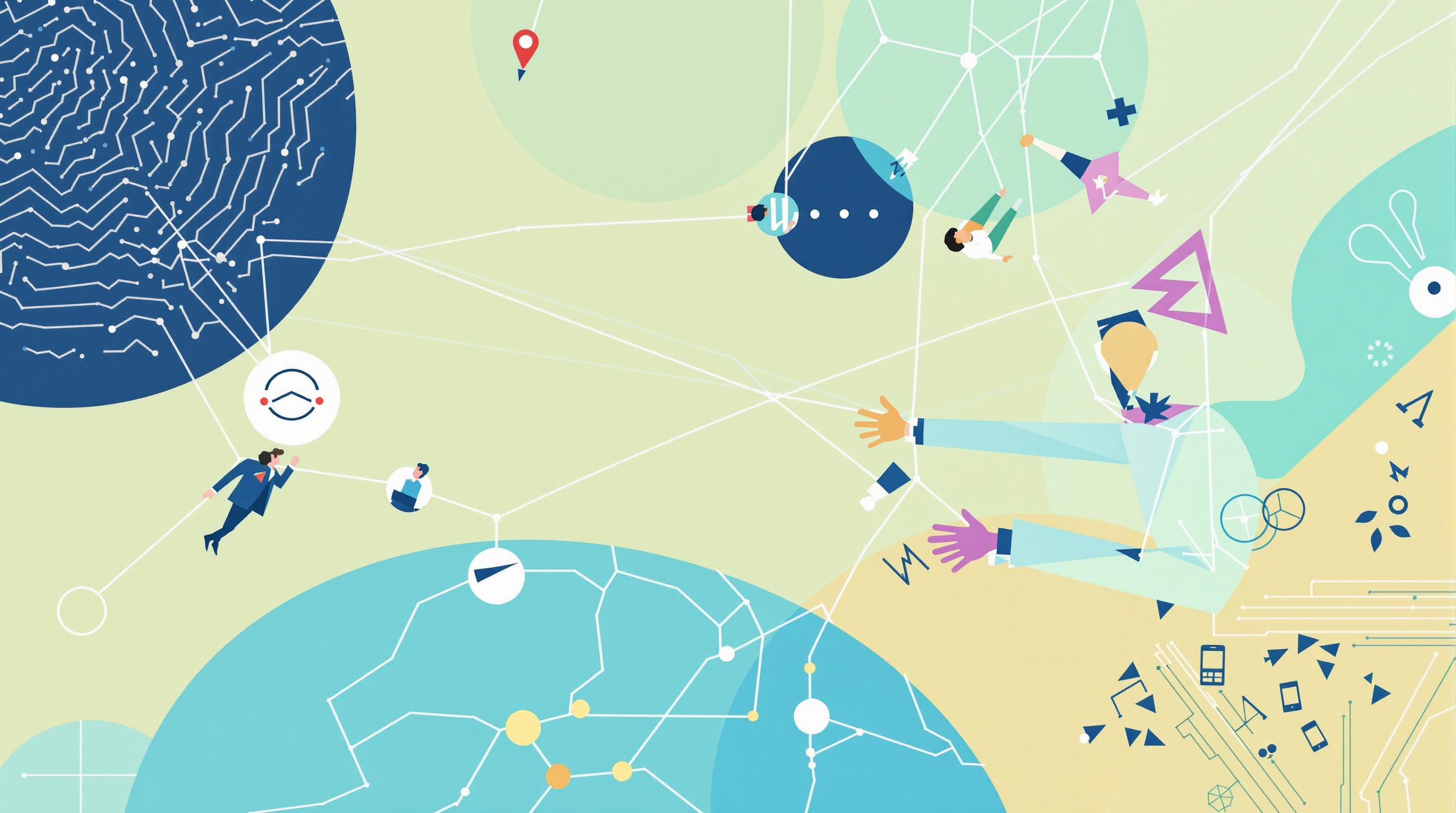Related Articles
- Uncharted Frequencies: The Surprising Role of Subcultures in Shaping Global Digital Landscapes
- Wired Whims: The Unexpected Role of Niche Online Communities in Shaping Global Digital Trends
- Fragmented Signals: Exploring the Shadows of Digital Divide in Emerging Economies and Its Impact on Global Unity
- Decoding the Invisible: How Microbial Communication Could Revolutionize Digital Interactions
- Cryptic Channels: How Encrypted Messaging Platforms Are Reshaping Trust and Transparency in Online Interactions
- Mysterious Modes: The Rise of Cryptographic Channels in Secret Online Dialogues and Their Hidden Impacts
12 Unseen Synergies: Revealing the Overlooked Connections Shaping Global Connectivity in the Blockchain Revolution
12 Unseen Synergies: Revealing the Overlooked Connections Shaping Global Connectivity in the Blockchain Revolution
12 Unseen Synergies: Revealing the Overlooked Connections Shaping Global Connectivity in the Blockchain Revolution
Introduction to Blockchain Synergies
The blockchain revolution is more than just a technological advancement; it is a paradigm shift altering how we perceive trust, connection, and value exchange. From finance to supply chain management, countless industries are recognizing the impact of decentralized technologies in shaping their futures. However, the focus on visible applications often overshadows the unseen synergies that are integral to global connectivity.
Understanding these synergies is vital because they forge connections between disparate sectors and communities, creating a more integrated economic landscape. These unseen relationships do not merely enhance existing systems; they pave the way for entirely new models of collaboration and innovation. As we dive deep into these connections, we will reveal how they collectively contribute to the broader blockchain narrative.
This exploration will illuminate the interconnected layers of the blockchain ecosystem, underscoring the importance of recognizing and nurturing these synergies as we continue to pave the way for the future of global connectivity.
1. Decentralized Identity and Privacy
The integration of decentralized identity solutions is vital in protecting personal data in our increasingly digital world. By leveraging blockchain technology, individuals can gain control over their own data, aiming to eliminate data breaches and unauthorized access. This emerging synergy between identity management and privacy empowers users to determine how their personal information is shared and utilized.
Moreover, this shift fosters a sense of trust and accountability among organizations. With verified credentials stored securely on the blockchain, businesses can interact with customers without the need for tedious and vulnerable data collection processes. This creates smoother, more efficient transactions while enhancing user confidence and satisfaction.
As decentralized identity solutions grow, they promise to reshape not just how we verify ourselves online, but the fundamental relationships we build with technology, companies, and each other.
2. Smart Contracts and Automated Governance
Smart contracts are revolutionizing the landscape of governance by removing intermediaries and introducing programmability in contractual agreements. This method enables automatic execution of transactions when predetermined conditions are met, minimizing conflicts and enhancing transparency. The synergy between smart contracts and automated governance has potential applications from legal contracts to international treaties.
By ensuring that all parties adhere to an immutable system, smart contracts could increase accountability in the public and private sectors alike. This increased efficiency creates a new layer of trust, allowing stakeholders to engage more freely and collaboratively without fear of exploitation or fraud.
Consequently, the evolution of governance through smart contracts lays the groundwork for more democratic decision-making processes, where each participant can have a voice while also being held to the same standards of transparency.
3. Supply Chain Transparency and Traceability
Blockchain technology has profound implications for supply chain management, thanks to its ability to track assets in real-time. The synergy between blockchain and supply chain transparency enables businesses to have greater insight into their operations, facilitating better decision-making. Each transaction is recorded on a transparent ledger, which reduces inefficiencies and fosters trust among stakeholders.
This traceability extends not only to products but also to ethical sourcing and sustainability efforts. With consumers becoming increasingly aware of the origins of their purchases, companies leveraging blockchain to demonstrate responsible sourcing can significantly enhance their brand value. They can prove the journey of an item, thereby fostering a greater connection between producer and consumer.
In this respect, blockchain is not just about enhancing logistic efficiencies; it symbolizes a shift towards a more conscientious and aware market where accountability and sustainability are inextricably linked.
4. Cryptocurrency's Role in Financial Inclusion
Cryptocurrencies are bridging gaps where traditional banking systems fall short, particularly in underserved regions. This transformative power of digital currencies provides individuals lacking access to financial institutions the opportunity to engage in the global economy. The synergy between cryptocurrencies and financial inclusion can reshape entire communities by empowering individuals through financial literacy and accessibility.
Furthermore, by operating outside conventional banking constraints, cryptocurrencies facilitate lower transaction fees and faster cross-border remittances. This empowers users to transact with confidence and support local economies without the burden of exorbitant costs.
The long-term ramifications of cryptocurrency adoption extend beyond individuals, potentially catalyzing broader economic development, increased entrepreneurship, and enhanced social mobility, fundamentally altering how economic opportunities are perceived and accessed.
5. NFTs and Digital Ownership
Non-fungible tokens (NFTs) have redefined the concept of ownership in the digital realm. This burgeoning field highlights the synergy between blockchain technology and artistic expression, enabling individuals to own and trade digital assets securely. By establishing unequivocal proof of ownership, NFTs provide creators with unprecedented opportunities to monetize their work while ensuring that they receive ongoing royalties from secondary sales.
This new model aligns the interests of artists and collectors alike, shifting the power dynamics in the creative space. As digital art continues to gain prominence, the visibility of NFTs opens doors to financial opportunities for previously marginalized creators, showcasing talents that might otherwise have gone unrecognized.
As the market for NFTs expands, our understanding of ownership will inevitably broaden, encompassing an array of concepts that challenge the traditional definitions of art, value, and community.
6. Decentralized Finance (DeFi) and Economic Empowerment
Decentralized Finance (DeFi) has emerged as a revolutionary force within the blockchain ecosystem, providing users with access to financial services without traditional intermediaries. The synergy between blockchain technology and DeFi platforms enables anyone with internet access to engage in lending, borrowing, and trading from anywhere in the world. This level of access is unprecedented and brings economic empowerment to traditionally excluded populations.
By democratizing access to financial products, DeFi has the potential to reshape traditional banking by reducing costs and removing barriers. Users can assume greater control over their financial futures, fostering innovation and experimentation in personal finance management.
As DeFi continues to evolve, its influence could inspire traditional financial institutions to adapt and innovate, creating a more inclusive model for financial services that prioritizes accessibility and user-centric solutions.
7. Cross-Industry Collaborations and Innovation
The blockchain space thrives on collaboration, with diverse industries exploring innovative ways to implement decentralized technologies. Synergies between sectors such as healthcare, entertainment, and logistics are driving groundbreaking solutions that address real-world challenges. By fostering partnerships, organizations can harness collective knowledge and creativity, ultimately leading to more effective outcomes.
These cross-industry efforts not only yield tangible benefits but also nurture a culture of innovation. By breaking down silos and encouraging communication across sectors, stakeholders can create sophisticated solutions that are adaptable and responsive to market needs.
As collaboration continues to flourish in the blockchain realm, the emergence of novel applications will serve as a testament to the power of shared visions and cooperative frameworks in tackling global issues.
8. Tokenization of Real-World Assets
Tokenization, the process of converting physical assets into digital tokens on a blockchain, is a significant realization of the synergies inherent in the blockchain ecosystem. This innovative approach allows for fractional ownership, enabling a broader range of investors to engage with previously inaccessible markets, such as real estate, art, and commodities.
By creating real-time liquidity and opening the doors to micro-investments, tokenization has the potential to democratize wealth accumulation. Sellers can attract a global audience of investors, while buyers gain more investment options, fundamentally transforming how assets are viewed and traded.
The implications of tokenizing real-world assets are vast, fostering a more inclusive financial landscape where investment opportunities are not limited to a select few but can be democratized for the many.
9. Education and Awareness in Blockchain Technology
Education and awareness play a crucial role in the adoption of blockchain technologies. As businesses and individuals become more informed about the benefits and applications of blockchain, they can harness its capabilities more effectively. The synergy between education initiatives and blockchain technology is essential for fostering a culture of understanding and innovation in the industry.
By bridging the knowledge gap, educational programs can empower individuals with the skills needed to explore career opportunities in this burgeoning field. Researchers and thought leaders can work collaboratively to create resources that inspire curiosity and engagement, encouraging a new generation to contribute to the blockchain narrative.
Ultimately, a well-informed populace can drive demand for transformative solutions. As more individuals recognize the potential of blockchain, this knowledge can fuel further innovation and catalyze societal shifts in diverse sectors.
10. Conclusion: Embracing Unseen Synergies
The unseen synergies within the blockchain revolution offer critical insights into the connections shaping our global landscape. By recognizing these relationships, stakeholders can more effectively leverage the power of blockchain to address pressing challenges and create sustainable solutions. Embracing these synergies encourages collaboration and mutual support, ultimately leading to a more resilient and interconnected world.
As we continue to explore the transformative potential of blockchain technology, it becomes imperative to nurture and cultivate these unseen connections. Doing so not only enhances our understanding of the technology's impact but also empowers communities to take charge of their futures in innovative ways.
The journey into this decentralized future is just beginning. By harnessing the synergies of blockchain, we can elevate human potential and foster a culture rooted in collaboration, transparency, and empowerment.




